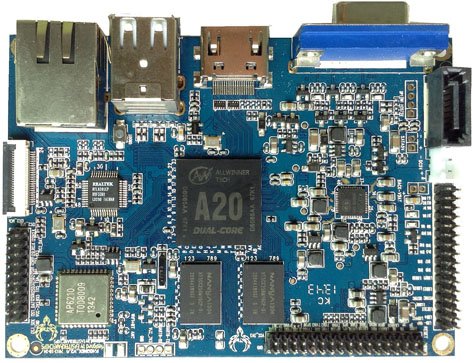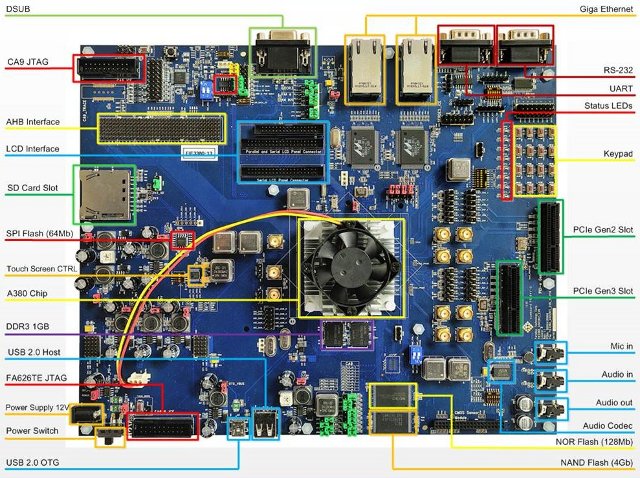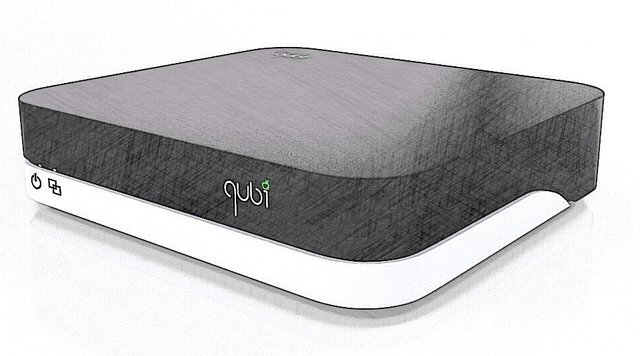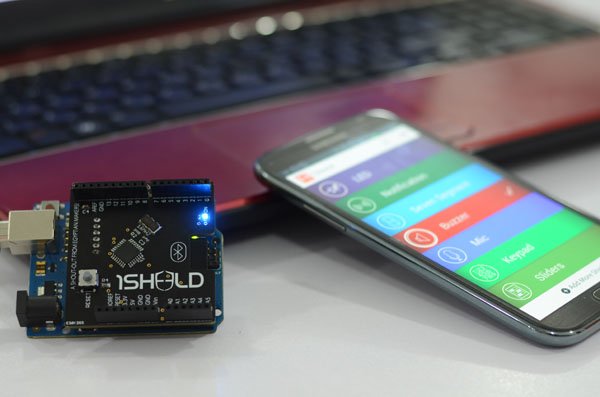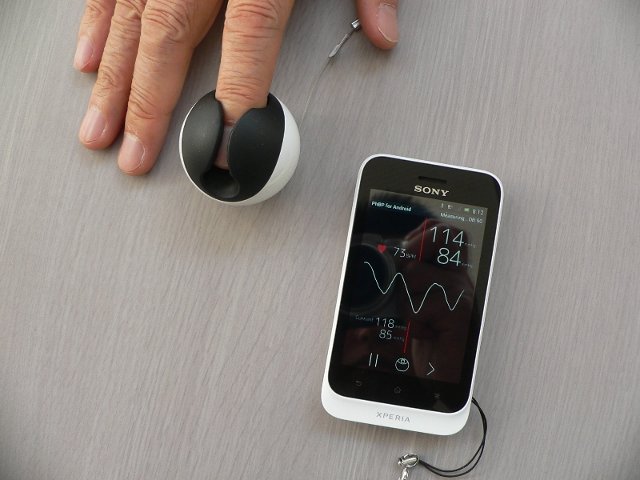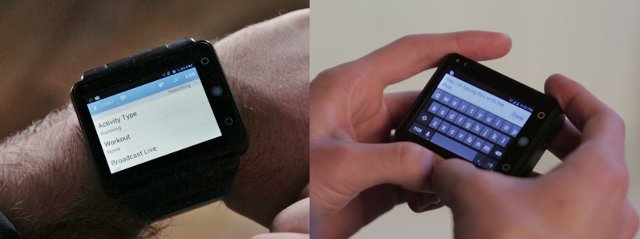Anichips Technology, a Shenzhen based electronics design company, has just announced PhoenixA20, a pico-ITX board features AllWinner A20 dual core Cortex A20 SoC with 1GB, 4GB Flash, HDMI and VGA output, Ethernet, and built-in Wi-fi and Bluetooth. PhoenixA20 specifications: SoC- AllWinner A20 dual ARM Cortex-A7 processor @ 1.2 GHz with ARM Mali-400MP2 GPU System Memory – 1GB DDR3 Storage – 4GB NAND Flash, micro SD card slot (up to 32GB), and SATA Video output – HDMI and VGA connectors. LVDS, RGB and CVBS signals are accessible via the expansion headers Connectivity – 10/100M Ethernet, Wi-Fi & Bluetooth 4.0 (via AP6210) USB – 2x USB 2.0 host ports Camera Interface – CSI Expansion headers – 3x UART, 2x I2C, 1×I2S, 1xCVBS, 4x TVIN, 2x Line IN, 1x SPDIF, 2x PWM, 2x LRADC, 2x FMIN, 1xHeadphone, 4xTVOUT, MIC, IR, TP The board supports Android 4.2.2, and Linux 3.3 with source code for […]
Faraday Technology SoCreative! IV Kit Facilitates Custom SoC Design and Software Implementation
Faraday Technology has unveiled “SoCreative! IV”, a SoC development kit based on Faraday A380 SoC featuring a dual-core ARM Cortex A9 processor, an ARMv5-compliant core developed by the company, and a high speed expansion bus for interfacing with FPGA daughtercards. A380 SoC has been designed for cloud infrastructure market, including networking, computing, and storage applications. The company has not listed the specifications, but here’s what I could derived from the picture above, and the info found on Linux Gizmos article. SoC – Farady A380 dual core Cortex A9 @ 1GHz, with ARMv5-compliant FA626TE RISC processor @ 500MHz, and 512MB L2 cache. BGA package (31x31mm), 40nm process. System Memory – 1GB DDR3-1600 RAM Storage – 4Gb NAND Flash (512MB), 128Mb of NOR flash, 64Mb of SPI flash, I2C EEPROM, and SD Card slot. Video Output – DSUB for 24-bit LCD I/F up to 1280×1280 Audio – Mic In, Audio In/Out, Audio […]
Qubi Android Media Center Features Qualcomm Snapdragon 600 SoC
Traditionally Qualcomm Application Processor have mostly been found in tablets, smartphones, and in development board such as the company’s own Mobile Development Platforms (MDP) or MyDragonBoard boards. But recently, a Snapdragon S4 has found its way into a smartwatch and today, I’ve found an upcoming, or maybe not, media player powered by Qualcomm Snapdragon 600. Beside Qualcomm quad core Krait SoC, Qubi Android media center features 2 GB RAM, 16 GB NAND Flash, dual band Wi-Fi b/g/n/ac, Gibabit Ethernet, and more. Here are the specifications of the device: SoC – Qualcomm Snapdragon 600 Quad Core Krait CPU @ 1.7 GHz with Adreno 320 GPU System Memory – 2GB RAM Storage – 16GB NAND Flash + microSD slot Connectivity – Dual band Wi-Fi b/g/n/ac, Gigabit Ethernet, and Bluetooth 4.0 Video Output – HDMI with HDMI-CEC support Audio Output – HDMI, optical SPDIF Video – 1080p video decoding USB – 3x USB […]
1Sheeld Arduino Shield Leverages Your Android Smartphone Hardware
To get started with Arduino, a simple board is enough, with soon, you’ll need to add shields for Wi-Fi, sensors, maybe a small display, etc.. and costs add up. Integreight, an Egyptian startup, had to idea to create a simple shield called 1Sheeld that can leverage your smartphone hardware assets such as Wi-Fi, LEDs, sensors, the display, the speaker, etc.., so you don’t have to spend extra money on shields. Technical Specifications: Runs on an ATmega162 @ 16 MHz Uses a standard HC-06 adapter (Bluetooth 2.0) providing up to 30 feet range (about 9 meters) Uses a modified version of the Firmata protocol Can communicate with Arduino using UART 50mA current draw That’s for the hardware, and there’s also a software platform and Android app to manages the communication between the shield and the smartphone, and select different shields options. You’d have to write your sketch using the company’s library, […]
ICMe Cuffless Finger Blood Pressure Monitor Sends Results to your Smartphone via Bluetooth 4.0
Nihon University have developed a tiny blood pressure monitor, which you can just touch with your finger, in order to get maximum and minimum (systolic and diastolic) blood pressures, both average and real-time values, as well as pulse rate and pulse waveform displayed on your smartphone. ICMe uses photo transistors to detect LED light reflected on a finger, and then converts pulse wave data obtained from the light to a blood pressure value. Phase Shift Method-based data processing and algorithm is used for the conversion to a blood pressure value, and results are transmitted to the phone via Bluetooth 4.0 (LE?). The device is composed of a custom main chip, LEDs, photo transistors, and a Bluetooth 4.0 module. Tech-on reports an early much larger model was exhibited last year at Medica 2013, and the new miniaturized model is currently showcased at Medica 2013, which runs from Nov 20 to 23, […]
Embedded Linux Conference Europe 2013 Videos and Presentation Slides
I uploaded several Embedded Linux Conference Europe videos in 2011 and 2012 that were hosted by Free Electrons and/or the Linux Foundation for download, but this year, it seems the Linux Foundation has discovered a new (to them) online video service called YouTube, and created a playlist with (for now) 18 sessions of ELCE 2013. I’ve embedded the playlist below starting with the “Status of Embedded Linux (2013)“, by Tim Bird, Sony Mobile which takes place every year, and is among the most popular presentations. Most of ELCE 2013 presentation slides are already available from eLinux.org. You can also have a look at the list of ELCE 2013 talks I featured before the event took place. [Update: I’ve just watched the Status of Embedded Linux video, and I though it may be interested to list the topics (and keywords) used for what has happened in embedded linux in the last […]
Neptune Pine SmartWatch Phone Powered by Snapdragon S4 Dual Core Processor
More and more companies are jumping on the smartwatch bandwagon. Neptune Computer, a Canadian based startup, has just launched a Kickstarter campaign for the Pine, a watchphone running Android 4.1.2, and featuring a Qualcomm Snapdragon S4 dual core SoC. On the surface it looks very similar to SGPAX S5 smartwatch which also features a dual core processor (Mediatek MT6577), and a SIM card slot, and runs Android 4.0. Neptune Pine, however, comes with features and improvements which may make the 3 to 4 month “kickstarter wait” worth it: a larger 2.4″ detachable screen, larger internal storage, dual camera support, a larger battery providing up to 5 days in standby mode, and an IP67 rating that certifies the device to be dustproof and waterproof at depth of less than 1 meter. Neptune Pine specifications: SoC – Qualcomm Snapdragon S4 Dual-Core Processor @ 1.2Ghz System Memory – 512 MB RAM Storage – […]
Qualcomm Unveils Snapdragon 805 Processor with Full 4K Support
Qualcomm has just announced their “next generation” Snapdragon 805 “Ultra HD” processor, part of the Snapdragon 800 family. The SoC supports video playback and capture, image and graphics processing on display supporting Ultra HD (aka 4K2K or 2160p) resolution. Snapdragon 805 features four Krait 450 core up to 2.5GHz, and an Adreno 420 GPU which is claimed to have 40% more graphics processing than its predecessor: Adreno 330. Snapdragon 805 key features: High performance – Krait 450 quad-core CPU @ 2.5 GHz per core, memory bandwidth support of up to 25.6 GB/second. High graphics performance and Ultra HD resolution – Adreno 420 GPU with support for hardware tessellation and geometry shaders, and 4K processing. Connectivity – Integration with either the Qualcomm Gobi MDM9x25 or the Gobi MDM9x35 modem (just announced too) for cellular connectivity. Gobi MDM9x25 support LTE Category 4 with peak data rates of up to 150Mbps, and the […]


